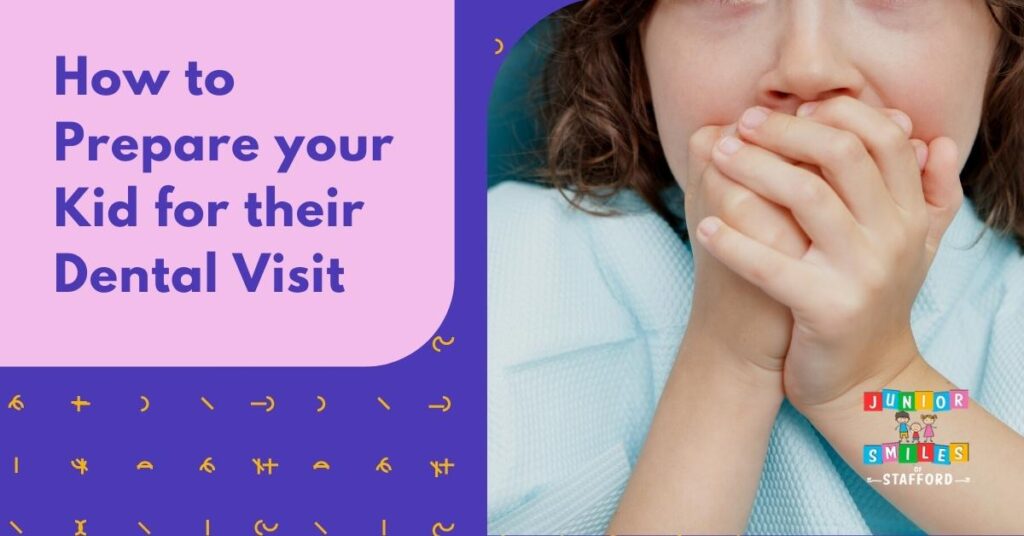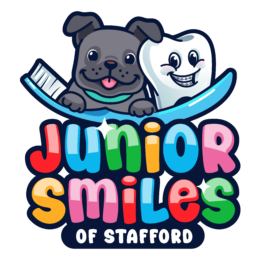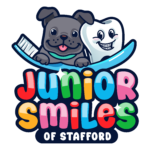Crafting Happy Smiles: A Guide to Making Kids’ Dentist Visits Enjoyable

Even for the little ones, going to the dentist could be a terrifying experience. Fears may begin to surface in the strange dental exam procedure and the unfamiliar clinic. But if you want your child to grow up with a healthy smile and normal jaw development, it’s important to start taking them to the dentist regularly, even when they’re little. That’s why the American Academy of Pediatric Dentistry states that children should see a dentist no later than their first birthday. When they’re little, they can get into the swing of things and make subsequent visits much easier.
You have come to the right place if you are seeking methods to greatly simplify the process of taking your child to the dentist. In this guide, we will explore various ways to make the dentist for kids a less intimidating and more enjoyable experience. Join us as we navigate the path to crafting happy smiles, ensuring that your child’s dentist visit is as comforting and cheerful as possible.
Preparing Your Child for a Stress-Free Trip to the Dentist
Preparing your little one for a stress-free trip to the dentist is crucial in ensuring a positive experience. It’s all about setting the right expectations and making them comfortable with the idea of going to the dentist. Start by having open conversations about what they can expect, and maybe even share some of your own experiences. Introduce them to the concept gently, perhaps through children’s books or fun videos about the dentist for kids.
For those first timers, consider playing pretend dentist games at home to demystify the process. Remember, the goal is to make your child’s dentist visit seem like an exciting adventure rather than a daunting task. With the right preparation, each visit can be a step towards instilling healthy dental habits in your child, ensuring they grow up with not just a healthy smile but also a confident attitude towards dental care.
Role of Positive Reinforcement During Dental Visits
When going to the dentist, how you frame and reward the experience may make or break your visit. This is especially true when taking a young child to the dentist; a little bit of encouragement may change their attitude. Be sure to compliment your youngster on their courage and cooperation both before and after the challenging event. Small tokens of appreciation, like a gift or incentive, can go a long way toward improving their opinions of future visits.
Actually, encouraging good behavior at the dentist is essential to building a trusting connection with your child’s oral health care provider. Thanking them for being brave will make their current appointment more bearable and set a good tone for their future dental checkups. By framing dental care as a process leading to good results, this method can help your kid overcome any anxiety they may have about going to the dentist and encourage them to look forward to their cleanings and exams.
Distraction Techniques for Anxious Kids at the Dentist
When it comes to managing anxiety for kids at the dentist, distraction techniques can be incredibly effective. These strategies are especially helpful for toddlers who might feel overwhelmed or scared. Here are some proven distraction techniques:
Storytelling and Imaginative Play
Get your kid thinking about what it might be like to see the dentist by starting a story about a courageous character. By drawing them into the narrative, this serves to both distract them and give them empowerment. It’s an imaginative and entertaining approach to easing anxiety about going to the dentist.
Interactive Toys or Gadgets
Be sure to bring your kid’s beloved plaything or small technological device. Bringing these things from home might help patients feel more at ease and at home in the strange setting of the dentist’s office. They work well in keeping the child’s hands and mind occupied.
Watching Cartoons or Videos
You can use your own device or one of the dental clinic’s displays to play their favorite movie or cartoon. One certain way to grab a kid’s attention is with a visual distraction. This might make them forget that the dental work is taking place.
Music or Audiobooks
Listen to calming music or an interesting audiobook with your youngster. With this aural diversion, they may unwind and divert their attention from the dental work at hand. Make sure the subject matter tickles their fancy.
Counting Games
Suggest a game where they mentally count objects or count everything in the room. Not only does it keep their attention, but it also stimulates their brains. Keeping children busy in this way is easy yet effective.
Kid-Friendly Waiting Room Activities for Toddlers at the Dentist
To help children feel more comfortable visiting the dentist, it is recommended to make the waiting area a more kid-friendly space. They will feel like the wait is going faster if you provide them something to do while they wait. A time-honored option, coloring books and crayons provide kids with a creative outlet. They may have fun while learning about dental care by coloring pictures that are relevant to the matter. Puzzles and stuffed animals in an interactive play area may be a lot of fun, too.
These designated play areas not only occupy toddlers’ time but also encourage them to engage with one another, creating a more laid-back and friendly environment. Finally, it can be reassuring and educational to have a children’s book corner stocked with a range of books, particularly ones that are related to dental care or going to the dentist. Not only can these things keep children occupied during the waiting time, but they also help them develop a pleasant relationship with the dentist, which is crucial for their future oral health.
Playful Introduction to Dental Tools
For children, particularly those experiencing their first visit to the dentist, a lighthearted introduction to dental instruments can help to alleviate any anxiety they may have about the appointment. One effective strategy for this is to incorporate a show-and-tell into the introduction. With the use of simple, kid-friendly terminology, the dentist may introduce the youngster to each tool—the mirror, the probe, and the brush—and explain its purpose.
For example, the dental mirror may be referred to as a “tooth mirror,” and the probe as a “tooth explorer.” They could also give the instruments interesting and creative names. In this way, the instruments take on a more human quality, resembling characters in a book. Making the tools familiar and less terrifying by letting the youngster touch and handle them (when it is safe to do so) is another excellent strategy. The child’s perspective might change from being afraid of the tools to being curious about them when this method is used. Young patients need a friendly, trusting relationship with their dentist before they can have a positive experience there. A lighthearted introduction like this one is perfect for that.
Interactive Learning about Oral Hygiene for Kids
If we want our children to develop good dental hygiene habits that will last a lifetime, we must teach them in an engaging and dynamic approach. Oral hygiene instruction for children through interactive learning may be a win-win: it can take boring tasks and make them more interesting. Using fun and engaging dental applications or games to teach proper brushing and flossing procedures is one excellent strategy. The inclusion of animations and entertaining characters in these digital tools makes learning more engaging for youngsters. Another strategy is to arrange for practical exercises, such as brushing a huge model of teeth, which not only shows the right way to do it but also helps kids remember what they’ve learned.
Arts and crafts projects like constructing a toothbrush or a plate for a nutritious meal are other great examples of hands-on activities that bring learning to life. With these, children learn about the need for good dental hygiene in an engaging and memorable way through these interactive approaches, which also provide them the tools they need to be active participants in their own dental health journey.
Creating a Comfortable Treatment Environment
Kids could feel scared when they see the big chair, sharp instruments, and dental tools in the dentist’s office. In order to alleviate children’s fears of dentists and other dental treatments, it is crucial that the dental clinic’s waiting room be warm and welcoming. The decor is the first point of contact and should be lively, vibrant, and interesting. Think about hanging up some lively murals or posters depicting cartoon characters or animals instead of dull artwork and clinical white walls.
Diffusing essential oils in the therapy room is one method to help youngsters relax during their visit. For young patients, this is an all-natural method of calming down in the treatment chair.
In addition to making aesthetic adjustments, dentists may make the office a more welcoming place for kids by modeling positive behavior and language while interacting with them. Put terms like “needle” and “drill” out of their minds; instead, use terminology that children can easily grasp. Consider how much more manageable the phrase “cleaning your teeth” is compared to the more daunting “scraping plaque off your teeth.”
Choosing the Right Pediatric Dentist
Selecting the right pediatric dentist is a critical decision for your child’s long-term dental health. Here are some key points to consider when choosing the right dentist:
Evaluate Communication Style
A great pediatric dentist communicates effectively with both the child and the parent. They should be able to explain procedures in a way that is easy for children to understand and be patient in answering any questions.
Read Reviews and Get Referrals
Check online reviews and ask friends and family for recommendations. Personal experiences can give you a good idea of what to expect and help you find a dentist who has a proven record of providing quality care.
Check for Parental Involvement
Choose a dentist who encourages parental involvement in the dental visits. This is especially important for toddlers and younger children, as the presence of a parent during the initial visits can significantly reduce anxiety.
Observe the Dental Environment
The atmosphere of the dental clinic should be welcoming and child-friendly. A good pediatric dental office will have a bright, cheerful decor, and possibly a play area, to make children feel more at ease. The staff should be warm and experienced in dealing with young patients.
Consider Convenience
Look for a dentist who is conveniently located and has office hours that fit your schedule. This makes regular visits less of a hassle, ensuring that your child’s dental care is consistent. It could also make it easier for your child to adjust, since it is not necessarily a whole new environment.
Discover a World of Gentle and Fun Dental Care at Junior Smiles of Stafford!
The journey to ensuring your child has a positive experience at the dentist is filled with various strategies, from preparing them for their visit to choosing the right pediatric dentist. Remember, the goal is to make dental visits a routine part of your child’s healthcare, building towards a future of healthy smiles and good oral hygiene. It’s about creating an environment that’s not only comforting but also educational and engaging for your child. By following the tips and techniques discussed in this guide, you can help alleviate any fears or anxieties your child may have and turn dental visits into a positive, empowering experience.
At Junior Smiles of Stafford we understand the importance of making dental visits enjoyable and stress-free for kids. Our team of compassionate professionals is dedicated to providing the best dental care in a warm, kid-friendly environment. We believe in crafting happy smiles and building lasting relationships with our little patients. Let us be a part of your child’s journey to excellent oral health. Book an appointment today and experience why families in VA trust us for their children’s dental needs.

